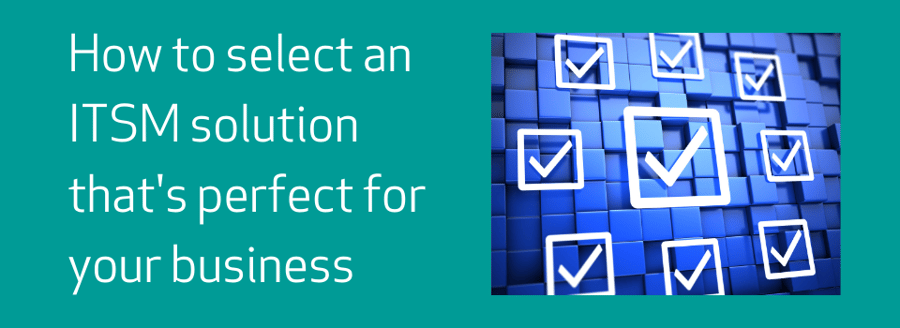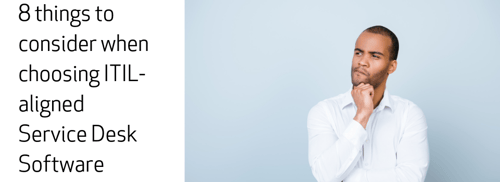Selecting an ITSM solution to match your needs can be a major undertaking.
You only have to search for ‘ITSM Solutions’ and you’ll arrive at the choice of any number of vendor websites, who on the face of it offer the same narrative and feature set, similar ITSM benefits and promise high levels of customer support. How do you filter the information and select the ITSM solution which is right for your organisation? When do you need to be flexible in your ideals and when should you stand your ground?
To ensure your services strategy runs smoothly to deliver the best ITSM benefits with an outstanding customer experience, here are some suggestions to work through.
1) Decide on your priorities
Only you and your team know the IT systems, processes, infrastructure and people that make up your organisation. To start the process of selecting the ITSM solution which best meets your needs, you’ll need to prioritise the essential supporting features of the software, i.e. those which are fundamental to a successful adoption as opposed to those which are on the probably extensive vendor list, but may not really be required.
It’s obvious, but all too often, organisations are blinded by extensively feature-rich software with all the bells and whistles going – usually coming at a price. It’s no good to find out too late that basic requirements aren’t being met – or are being met at exorbitant cost to support a number of features you just won’t use. A long feature list is all very well, but could be a challenge to successfully implement if the software’s not easy to configure and use on a daily basis. If your funding is limited and your team is happy to get stuck into the detail, a drag and drop workflow engine could resolve your process automation aspirations without huge consultancy add-ons.
Integration is a major issue with so many ‘best of breed’ applications making up the technology landscape, so making sure your ITSM solution will integrate seamlessly with your existing and planned systems is fundamental. A lack of APIs and compatibility can cause real problems in the longer term. In this age where remote working is the norm, updated communications from the ITSM solution into collaboration tools like Teams is an absolute must.
Security is a major factor to consider but isn’t a trade-off; really it should be a ‘given’ in these established times of SaaS technology. As long as your ITSM vendor is using a trusted SaaS partner, such as IBM Cloud, security and compliance really shouldn’t be an issue and you should reach an easy conclusion here. If you’re taking the on-premise installation route, make sure your in house team is aware of the ITSM project and can speak to the potential vendors about related security matters to help you decide.
2) Look beyond the hype
ITSM solution vendors have some pretty well appointed marketing machines; many ITSM tools may even be just a small part of larger platform selling organisation. There’s nothing wrong with the bigger picture, especially when boundaries between home and workplace and technologies are blurred, but keep your eyes open and see the gloss for what it is. Once you’ve checked the credentials of the software against what you need, then by all means look at the nice-to-have extra functionality that may be here now, planned or promised. It may be that you’re paying for features which you’ll never switch on, or which may not even see the light of day beyond the roadmap glittered with gold.
3) Allow for change
You need to be realistic though, balancing here and now with a future path, so it is crucial to work out how your ITSM requirements may develop over time. Take a lead from case studies of organisations like your own and see how their service strategy has evolved. Once you’ve started on the path to continuous improvement, it’s easier than you think to implement a self-service function for example, which seem many miles away right now. So, by all means compare solutions based on your current needs, but make sure it’s easy for you to move ahead and take advantage of common practices which seem further afield.
If your organisation is small, that doesn’t mean that you should ignore the advantages of ITSM solutions for growth, just make sure that there is flexibility to adapt and reconfigure the software without breaking the bank. An in-house gap analysis will show key areas that need attention and in which your service management needs to develop over time.
4) Consider ITIL
You don’t have to actively undertake full ITIL training and certification to see its merits or put them into practice, but it’s worth understanding enough to see why this industry best practice framework has been so widely adopted. Selecting an ITSM solution that supports ITIL will help to structure and put into practice the principles and benefits which follow. We’d say that few organisations of any size or type of business run their service desk 100% by the ITIL book, but pretty much everyone can benefit at least from a little of its wisdom.
5) Stand your ground
If you see the demo of the ITSM solution and despite the best efforts of the vendor’s sales team, you just don’t see it working for you, despite you asking questions about flexibility and tailoring, if it’s not for you, walk away. There are many ways to achieve an end goal of improving IT service provision and they won’t all fit. In the worst case, you could find yourself with a new ITSM solution with all the functionality you need but the practical handling isn’t aligned with your way of doing things and the effort required to reach that common point is too high.
You’ll be likely to have some processes which might not be the best way of achieving the same result, and these could be grounds for a healthy discourse with the new ITSM vendor, so be open minded as there could be a more effective solution. However, when push comes to shove, you shouldn’t have to swap tried and tested ways of working just to fit with a new software solution – automating what you have should be an easy step forward, not a deal breaker.
6) Look for proof points
It’s easy enough for an ITSM solution to tick all the boxes on paper, but real life experience is another story that can provide guidance and an idea of what’s to come for a new project. Any ITSM solutions vendor of credible status should be able to show a proven track record in your industry, with organisations of a similar size or showing similar pain points. More experience can only be helpful, so take a look at the case studies on show and don’t be afraid to ask the vendor for other insights they’ve gleaned from customer experiences. Some might not have made it to publication but are nevertheless insightful.
7) Assess organisational fit
You’re not choosing just an ITSM solution, you need to be sure that the vendor can be your supporting business partner for years to come, so several factors should be in line.
Common lines of questioning should assess
– Customer service – surveys and satisfaction rates
– How do they work – have they been responsive to questions
– Fairness – if you’re a smaller organisation, will you be treated equally with larger customers?
– Support hours, location and time factors




.png)
